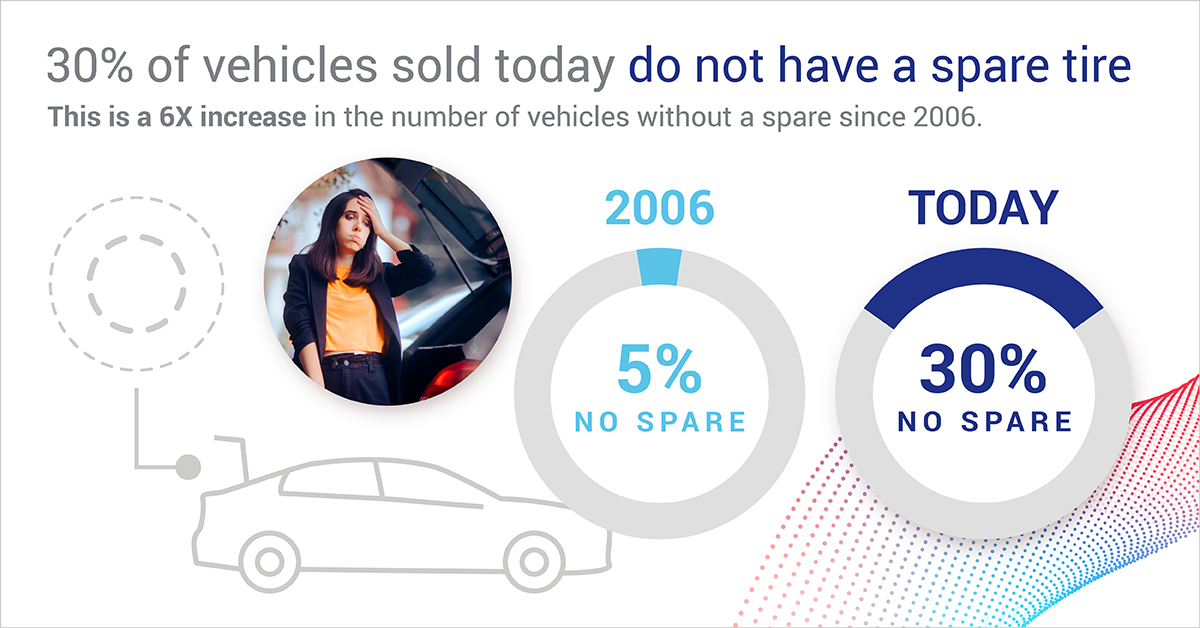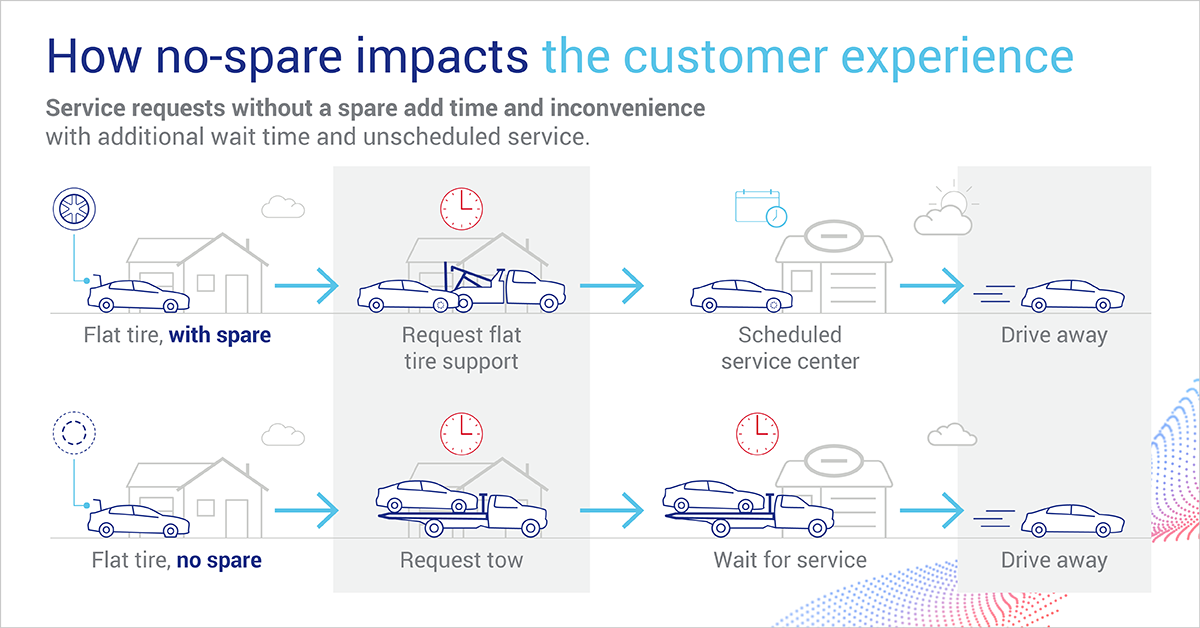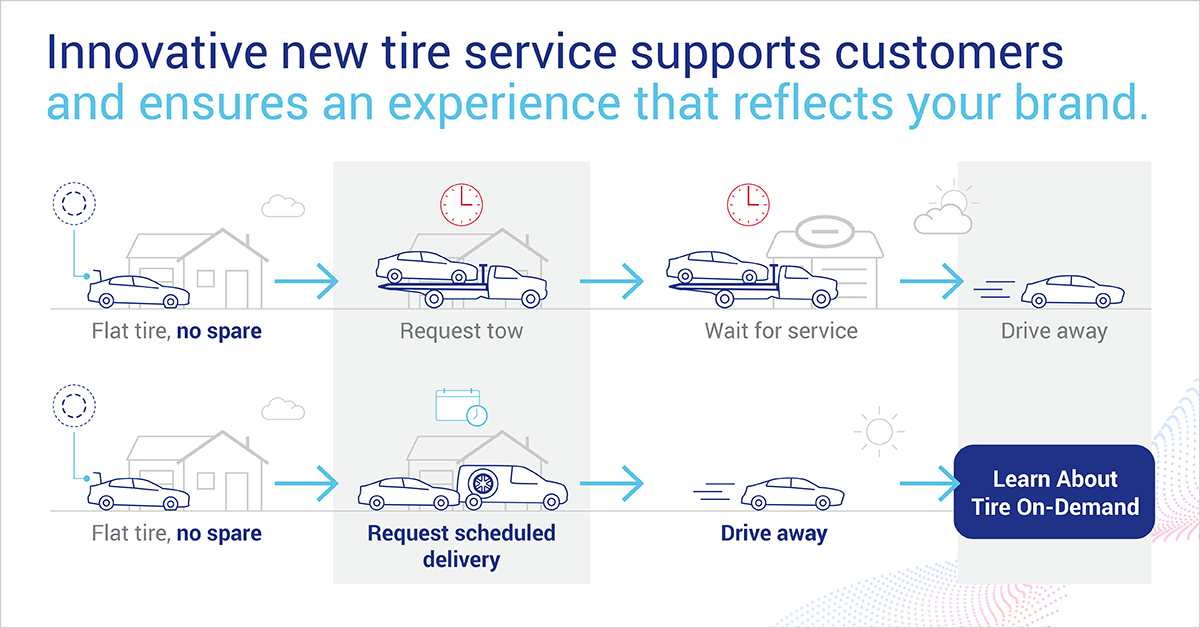Agero Insights

How flat tires have become the number one roadside hassle, especially for EVs
July 26, 2023 | 5 min read
Flat tires happen all the time – every 7 seconds - 220 million flat tires in the US every year, accounting for nearly 20% of all roadside events. In fact, flat tires are the most common roadside request we receive.
What used to be a 30 minute inconvenience - getting your hands a little dirty as you unpack the spare and do a quick tire change on the side of the road - is often now a 4+ hour ordeal including a lengthy tow event, driving to a service center, and waiting to buy and install a new tire.
Here’s the rundown on what’s changed, the customer impact, and what can be done to prevent degradation in customer experience and satisfaction.
What Changed: The brave new “no-spare” world
Back in 2006, only 5% of vehicles could be found without a spare. Today more than 30% of new vehicles sold do not have a spare. There are a few reasons for this spectacular decline.
Overall vehicle weight: Weight reduction has been a key factor in meeting fuel economy standards in combustion vehicles. In electric vehicles, any excess weight affects available range. Manufacturers are looking for opportunities to shave any pounds possible, and the spare tire has been an obvious target.
Run flat technology: Advancements in tire technology have also enabled the removal of the spare. The introduction of the run-flat tire has enabled drivers to travel for 50 miles at 50 mph on a flat, the same standard as most donut spare tires. About 15% of new vehicles are equipped with run-flat tires.
Self sealing & patch kits: Self sealing tires also seek to reduce the impact of a minor puncture by sealing the 5mm or less hole with a rubbery polymer liquid which lines the inside of the tire. Many vehicles also include a tire repair kit which is designed to support small punctures for short distances. These new tire types and kits are designed to support issues on the tread. However, neither can be safely driven if the puncture is on the side wall, which accounts for about 80% of tire punctures.
As a result, a growing number of vehicles are not equipped with a spare tire.

What else changed: More customers need help with flat tires
At Agero, we are seeing a consistent increase in the relative number of flat tire requests - increasing more than 20% since 2019. Here’s why:
Cars are heavier (especially EVs): Across the board, vehicles are heavier. Since 1990, trucks and SUVs have increased in weight by 32% and cars have increased by 7%. With electric vehicles, overall weight is even more of an issue because of the heft of the electric battery. In fact, electric vehicles can be as much as 50% heavier than their ICE counterparts. Heavier cars put more stress on the tires and contribute to more flat tires.
Maintenance compliance is a challenge (especially with EVs): For EVs, there are 45 fewer maintenance needs in the first 100K miles when compared with their ICE counterparts. However, without the natural 5K touchpoint, where most maintenance needs are taken care of, compliance is a challenge. Most EV owners assume no maintenance is required and will drive 10-20K without any maintenance. Without rotation and inspections, customers are more at risk for flat tires.
Consumers are less comfortable changing a flat tire: A growing number of people do not know how to change spare tires. About 50% of drivers over age 36 were confident in their ability to change a flat tire but that number drops to 27% for drivers between ages 18 and 23. These drivers are more likely to request professional assistance in the case of a flat tire.
Impact: Brand affinity and customer experience are declining through a poor but fixable customer experience journey
The wait time for service with a flat tire tow increases by 65%, from just under an hour, to more than 90 minutes. With this longer wait time, the customer experience suffers and NPS drops by nearly 20 points.
This makes sense - people hate waiting. A study by the American customer Satisfaction Index found that wait times are a key factor in customer experience. They found that customers with a longer wait were 18% less satisfied with their experience.
And in the case of the flat tire, waiting for the tow is just the first in a whole series of waiting. After waiting for the tow, they will need to wait for the vehicle to be loaded, then travel with the vehicle, and then wait at the service center for the purchase and installation of the new tire. This entire series is outside of the customer’s control and disruptive to their day.

What can be done: When flat tires are not an emergency, there is an opportunity
What if the customer didn’t have to be towed? Through our experience serving nearly 11 million customers a year, Agero witnessed the trend of increasing flat tire tows early and has begun solutioning.
More than 45% of the flat tire service requests received this year were requested from home or a parking lot at work. In these cases, there may be an opportunity to fully address the problem while minimizing the impact to the customer - allowing them to be productive ‘while they wait’.
- Schedule it: one of the best tactics in managing the impact of wait time is through setting expectations and allowing customers to be productive. Unoccupied time feels longer than occupied time. If the customer can continue about their day, at home or at work, with a scheduled time for support, this will reduce the impact of the wait time.
- Solve it all at once. Both donut spare or the tow are just step one in resolving a customer’s flat tire. Let’s solve the whole problem which in most cases means a new tire because only small punctures, up to ¼” along the tread are eligible for repair. Innovative partnerships can enable the direct delivery and installation of tires.
At Agero, we are committed to developing innovative services to meet the changing needs of our clients and their customers. We recognize the opportunity to eliminate tows for flat tires with optional tire delivery and installation, where and when your customers want. To learn more about this program, click here. To join this exciting pilot to see how we can support your customers and your brand, contact your client success manager.
Meet the Author: Shana Cooper - Senior Director, Product Marketing
 Shana Cooper leads the Product Marketing team at Agero. She joined the team in 2019 and has helped build and shape product content and education across all lines of business. Prior to Agero, Shana worked in a range of early stage start-ups covering everything from robots to biotech to IoT consumer products. She loves the challenge of helping to understand and communicate complex products. Shana has a BA in Chemistry from Colgate University and an MBA from Boston University.
Shana Cooper leads the Product Marketing team at Agero. She joined the team in 2019 and has helped build and shape product content and education across all lines of business. Prior to Agero, Shana worked in a range of early stage start-ups covering everything from robots to biotech to IoT consumer products. She loves the challenge of helping to understand and communicate complex products. Shana has a BA in Chemistry from Colgate University and an MBA from Boston University.Recent Posts
Agero’s Bob Sullivan Wins 2025 National ORBIE® Award
Recognition marks third consecutive year the esteemed award program has honored Sullivan as an...Agero Welcomes Former Cox Automotive CEO Sandy Schwartz to Board of Advisors
Renowned auto industry veteran to guide strategic growth, underscoring Agero’s commitment to...Why Your Reimbursement Process Matters More Than You Think
Roadside reimbursements have long been a source of operational strain that can also create customer...

